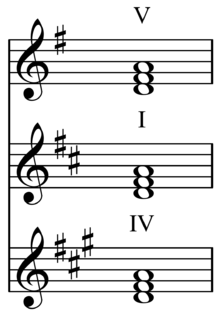Common chord (music)

A common chord, in the theory of harmony, is a
Common chords are frequently used in modulations, in a type of modulation known as common chord modulation or diatonic pivot chord modulation. It moves from the original key to the destination key (usually a closely related key) by way of a chord both keys share. For example, G major and D major have 4 chords in common: G, Bm, D, Em. This can be easily determined by a chart similar to the one below, which compares chord qualities. The I chord in G major—a G major chord—is also the IV chord in D major, so I in G major and IV in D major are aligned on the chart.
| C major: | V | vi | viio | I | ii | iii | IV |
|---|---|---|---|---|---|---|---|
| G major: | I | ii | iii | IV | V | vi | viio |
| D major: | IV | V | vi | viio | I | ii | iii |
Any chord with the same
A chord is common to, or shared by, six keys: three major keys, and three relative minor keys. For example, a C major chord is contained in F, C, and G major as well as D, A, and E minor.
Related keys
The number of diatonically occurring chords that two keys share is a measure of how closely related they are. A
For example, C major and A minor have 7 common chords while C major and F♯ major have 0 common chords.
| C | CEG | DFA | EGB | FAC | GBD | ACE | BDF |
|---|---|---|---|---|---|---|---|
| F | CEG | DFA | FAC | ACE | |||
| G | CEG | EGB | GBD | ACE | |||
| D | EGB | GBD | |||||
| B♭ | DFA | FAC |
See also
References
- ISBN 978-0-07-294262-0.
- ^ Johnson, A. N. (Artemas Nixon) (1855). Practical instructions in harmony, upon the Pestalozzian or inductive system; teaching musical composition and the art of extemporizing interludes and voluntaries. University of California Libraries. Boston: Oliver Ditson and Company. p. 5.
A common chord is composed of three letters, so arranged that the second letter is at the interval of a third, and the third letter at the interval of a fifth, from the first letter.
- ISBN 978-0-02-864155-3.
- ^ "chord". Oxford English Dictionary (Online ed.). Oxford University Press. (Subscription or participating institution membership required.), entry "chord, n.2", sense 3.a.
- ISBN 9780198614593.
- ISBN 978-0-19-866212-9.
- ISBN 9780195170672
- ISBN 978-0-674-01163-2. "Common chord: Major triad."
